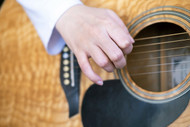Fingerstyle Mastery: A Beginner's Guide to Finger Picking on Guitar
Mar 8th 2024

Fingerstyle Mastery: A Beginner's Guide to Fingerpicking on Guitar
Although many people use a pick/plectrum to play the guitar, it’s not a requirement. On the contrary, some of the world’s best-known guitarists like Chet Atkins, John Mayer, Mark Knopfler, Bonnie Raitt and Graham Lyle have achieved distinct sounds by abandoning the pick at times and using their fingers to pluck the strings.
Guitar fingerpicking goes by many names, including fingerstyle guitar, pattern picking and thumb picking. Regardless, it refers to both the playing technique and the subgenre of music it’s spawned. From classical guitar to jazz, country to rock n’ roll, fingerpicking is a huge part of music. The sweeping loneliness of “Yesterday” by The Beatles? The melancholy adventure of “Road Trippin’” by Red Hot Chili Peppers? Those songs and many others wouldn’t sound the same if played with a pick.
Are you looking to expand your musical horizons? Fingerpicking is a great way to do it. In this introductory guitar fingerpicking guide, the experts at Strings and Beyond go over the benefits of guitar fingerpicking and why to use it. We also have a few fingerstyle guitar tips for musicians who want to add it to their repertoire.

So What is Guitar Fingerpicking, Exactly?
The easy answer is that fingerstyle picking means using your fingers to play the strings independently. However, just like you can do more than pluck single strings with a pick, you can do more than just pluck with fingerstyle play. This technique is often used to play two, three or even five strings at once with different fingers, letting guitarists create sounds and harmonies they wouldn’t otherwise be able to. You can even tap on the guitar as you play for added effect — or strum full chords like you normally would.
Fingerstyle play is most common when using nylon strings. You can fingerpick on steel strings, but you will need to gradually build up your finger calluses and strength. Some finger pickers grow their fingernails long for plucking and strumming, creating a hybrid sound with elements of fingerstyle and plectrum play.
Pros and Cons of Guitar Finger Picking
Advantages of Finger Picking
1.One person can perform several music elements — chord progressions, melodies, bass line and percussion — at the same time, creating a fuller arrangement when playing unaccompanied.
2.You only play the strings you want to play with no muting necessary.
3.The notes offer a softer sound and a more piano-like timbre for when this is desired.
4.You don’t have to bring picks everywhere you play or worry about dropping them in the middle of a song.
Disadvantages of Finger Picking
1.The technique is harder to learn since it requires much more complexity and precision than a plectrum.
2.You won’t have as strong an attack, making fingerpicking impractical for more driving musical styles.
3.Since you’re touching the strings with both hands, they are exposed to more oil build-up and moisture that can cause corrosion.
4.Fingerpicking is more likely to result in damaged fingertips and chipped nails, especially when playing on heavier gauge steel strings. Some guitarists will “cheat” by wearing artificial acrylic nails and even a thumb pick when they play fingerstyle.

Guitar Fingerpicking Tips
Now that you know the background of fingerpicking, what should you do to get started? Here are 10 tips for learning how to fingerpick:
1.Start out on nylon strings or light-gauge steel strings since they are easier on the fingers. We offer a variety of strings from leading brands — including John Pearse, who was a well-known fingerstyle player.
2.Begin with fingerpicking just one string. As you get the hang of it, progress to two strings and beyond.
3.To produce the leverage you need, position your thumb ahead of the fingers, have your fingers at about a 90-degree angle relative to the strings and position your wrist above the strings rather than next to them.
4.Try to keep your wrist and arm still so the fingers are the only thing moving.
5.Use your thumb to play the 6-4 strings, your index finger for the 3-string, your middle finger for the 2-string and your ring finger for the 1-string. You can eventually progress to other combinations (as well as using your pinky), but these rules are a good place to start.
6.Focus on the melody notes in a song. These are more recognizable by an audience, making them more important to play and play well.
7.Pluck the bass notes harder than the other notes. This will add the foundation that helps fill out the sound.
8.Keep your fingernails around the same length. How long they are is up to you, but constantly changing fingernail length will greatly affect the tone, timbre and feel. Make sure they’re trimmed smoothly as well since angles and jagged edges can catch on the strings.
9.Practice, practice, practice. Muscle memory will be important for mastering complex fingerpicking songs, and the only way to achieve muscle memory is to practice.
10.Don’t forget to listen to how the music sounds and feels! Some people get so lost in the technical aspects of fingerpicking that they lose the groove and soul that makes music so powerful.

Guitar Finger Picking Songs for Beginners
Are you looking for a relatively easy way to get started with fingerpicking? Here are some beginner fingerstyle guitar songs and a few intermediate songs to practice your skills:
1.“Fast Car”, Tracy Chapman
2.“Hey There Delilah”, Plain White T’s
3.“Everybody Hurts”, REM
4.“Ain’t No Sunshine”, Bill Withers
5.“Nothing Else Matters” Metallica
6.“Freight Train”, Elizabeth Cotten
7.“House of the Rising Sun”, The Animals
8.“Landslide”, Fleetwood Mac
9.“Dust in the Wind”, Kansas
10.“Jolene”, Dolly Parton

